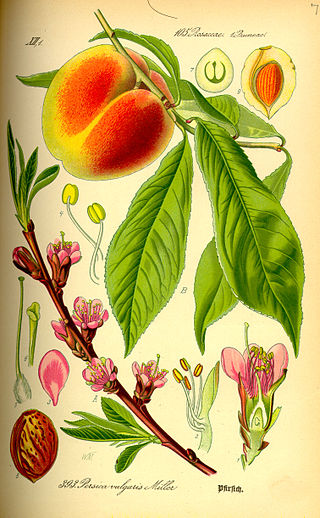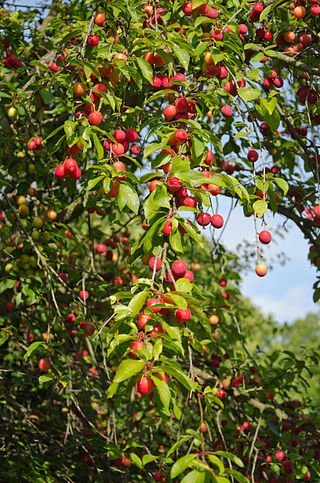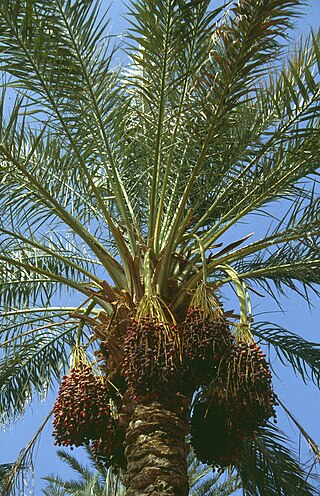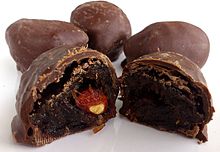
The peach is a deciduous tree first domesticated and cultivated in Zhejiang province of Eastern China. It bears edible juicy fruits with various characteristics, most called peaches and others, nectarines.

An apricot is a fruit, or the tree that bears the fruit, of several species in the genus Prunus.

A plum is a fruit of some species in Prunus subg. Prunus. Dried plums are most often called prunes, though in the United States they may be just labeled as 'dried plums', especially during the 21st century.

Dietary fiber or roughage is the portion of plant-derived food that cannot be completely broken down by human digestive enzymes. Dietary fibers are diverse in chemical composition, and can be grouped generally by their solubility, viscosity, and fermentability, which affect how fibers are processed in the body. Dietary fiber has two main components: soluble fiber and insoluble fiber, which are components of plant-based foods, such as legumes, whole grains and cereals, vegetables, fruits, and nuts or seeds. A diet high in regular fiber consumption is generally associated with supporting health and lowering the risk of several diseases. Dietary fiber consists of non-starch polysaccharides and other plant components such as cellulose, resistant starch, resistant dextrins, inulin, lignins, chitins, pectins, beta-glucans, and oligosaccharides.

Prunus is a genus of trees and shrubs in the flowering plant family Rosaceae that includes plums, cherries, peaches, nectarines, apricots, and almonds. The genus has a cosmopolitan distribution, being native to the North American temperate regions, the neotropics of South America, and temperate and tropical regions of Asia and Africa, There are 340 accepted species. Many members of the genus are widely cultivated for their fruit and for decorative purposes. Prunus fruit are drupes, or stone fruits. The fleshy mesocarp surrounding the endocarp is edible while the endocarp itself forms a hard, inedible shell called the pyrena. This shell encloses the seed, which is edible in some species, but poisonous in many others. Besides being eaten off the hand, most Prunus fruit are also commonly used in processing, such as jam production, canning, drying, and the seeds for roasting.

The persimmon is the edible fruit of a number of species of trees in the genus Diospyros. The most widely cultivated of these is the kaki persimmon, Diospyros kaki – Diospyros is in the family Ebenaceae, and a number of non-persimmon species of the genus are grown for ebony timber. In 2019, China produced 75% of the world total of persimmons.

Morus, a genus of flowering plants in the family Moraceae, consists of diverse species of deciduous trees commonly known as mulberries, growing wild and under cultivation in many temperate world regions. Generally, the genus has 64 subordinate taxa, three of which are well-known and are ostensibly named for the fruit color of the best-known cultivar: white, red, and black mulberry, with numerous cultivars and some taxa currently unchecked and awaiting taxonomic scrutiny. M. alba is native to South Asia, but is widely distributed across Europe, Southern Africa, South America, and North America. M. alba is also the species most preferred by the silkworm, and is regarded as an invasive species in Brazil and the United States.

Laxatives, purgatives, or aperients are substances that loosen stools and increase bowel movements. They are used to treat and prevent constipation.

Guava is a common tropical fruit cultivated in many tropical and subtropical regions. The common guava Psidium guajava is a small tree in the myrtle family (Myrtaceae), native to Mexico, Central America, the Caribbean and northern South America. The name guava is also given to some other species in the genus Psidium such as strawberry guava and to the pineapple guava, Feijoa sellowiana. In 2019, 55 million tonnes of guavas were produced worldwide, led by India with 45% of the total. Botanically, guavas are berries.

The raspberry is the edible fruit of a multitude of plant species in the genus Rubus of the rose family, most of which are in the subgenus Idaeobatus. The name also applies to these plants themselves. Raspberries are perennial with woody stems.

The Brussels sprout is a member of the Gemmifera cultivar group of cabbages, grown for its edible buds.

The greengages are a group of cultivars of the common European plum. The first true greengage came from a green-fruited wild plum which originated in Iran (Persia). Greengages are grown in temperate areas and are known for the rich, confectionery flavour. They are considered to be among the finest dessert plums; Anna Pavord calls them "most ambrosial of all tree fruit" and David Karp describes them as "the best fruit in the world".

The damson or damson plum, also archaically called the "damascene", is an edible drupaceous fruit, a subspecies of the plum tree. Varieties of insititia are found across Europe, but the name damson is derived from and most commonly applied to forms that are native to Great Britain. Damsons are relatively small ovoid plum-like fruit with a distinctive, somewhat astringent taste, and are widely used for culinary purposes, particularly in fruit preserves and jams.

Prunus cerasifera is a species of plum known by the common names cherry plum and myrobalan plum. It is native to Southeast Europe and Western Asia, and is naturalised in the British Isles and scattered locations in North America. Also naturalized in parts of SE Australia where it is considered to be a mildly invasive weed of bushland near urban centers. P. cerasifera is believed to one of the parents of the Cultivated Plum, Prunus domestica perhaps crossing with the sloe, Prunus spinosa, or perhaps the sole parent. This would make it a parent of most of the commercial varieties of plum in the UK and mainland Europe - Victoria, greengages, bullace etc.

Mirabelle plum is a cultivar group of plum trees of the genus Prunus. It is believed that the plum was cultivated from a wild fruit grown in Anatolia.

Prunus salicina, commonly called the Japanese plum or Chinese plum, is a small deciduous tree native to China, Taiwan and Southeast Asia. It is an introduced species in Korea, Japan, Israel, the United States, and Australia.

Prune juice is a fruit juice derived from prunes that have been rehydrated. It is a mass-produced product that is often produced using a hot extraction method, and juice concentrate is typically produced using a low-temperature extraction method. It may be used as a dietary supplement to act as a laxative. It is also sometimes used as a flavor enhancer in tobacco products. It is an ingredient in many cocktails, such as the Purple Dragon, or Constipolitan.

Prunus domestica is a species of flowering plant in the family Rosaceae. A deciduous tree, it includes many varieties of the fruit trees known as plums in English, though not all plums belong to this species. The greengages and damsons also belong to subspecies of P. domestica.

The prune plum is a fruit-bearing tree, or its fruit. It is a subspecies of the plum Prunus domestica. The freestone fruit is similar to, but distinct from, the clingstone damson and is especially popular in Central Europe.

Mazafati is a cultivar of the palm date. It is a dark, soft, fleshy and sweet date of medium size, about 2.5–4.5 cm (1–2 in) with a relatively high moisture content of between 32 and 35%, varying with the time of harvest and the location of the grove.























